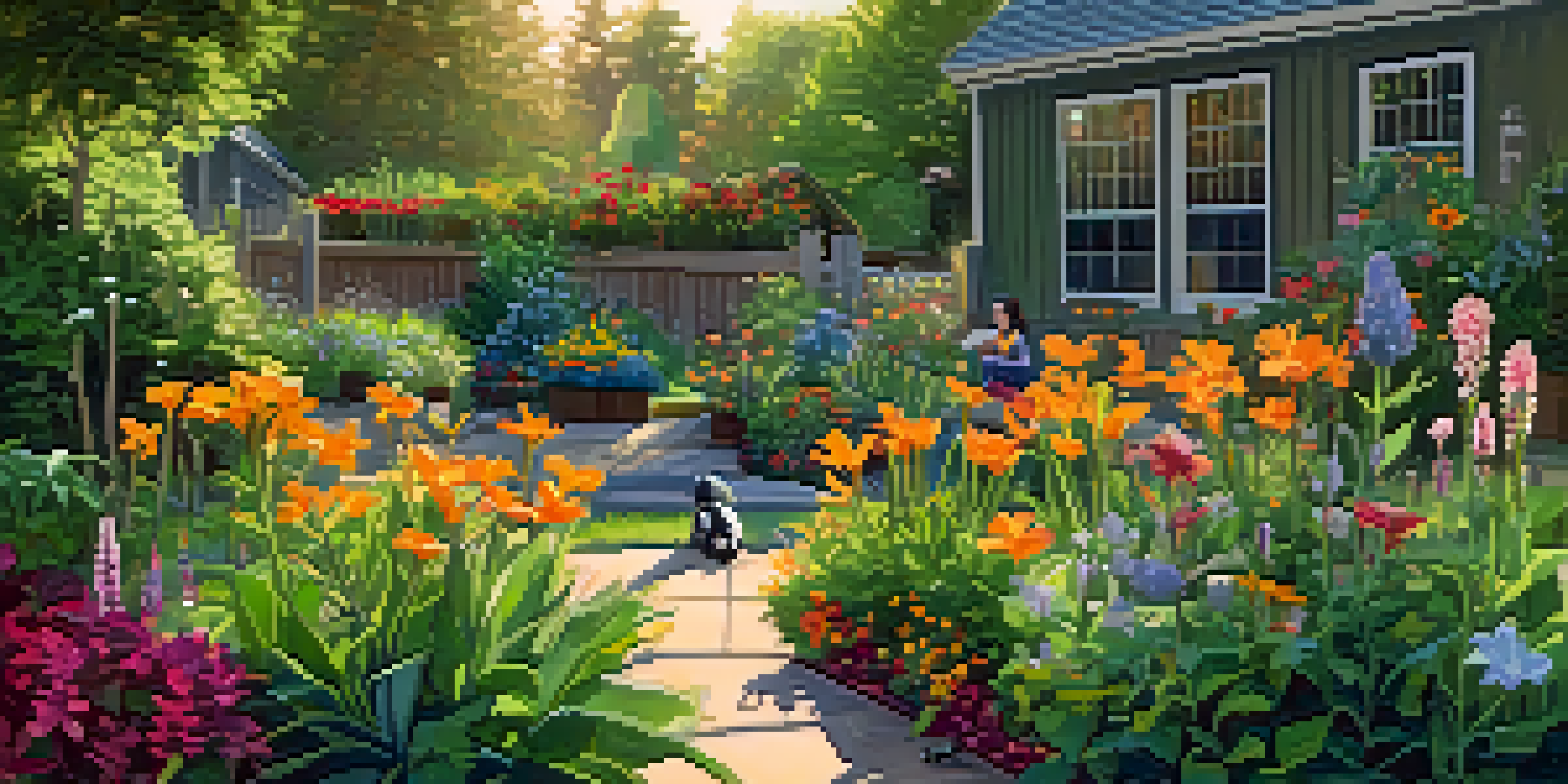Sustainable Garden Planning: Step-by-Step Guide

Understanding Sustainable Gardening: What It Means
Sustainable gardening is all about working in harmony with nature. It involves practices that protect the environment while providing a healthy space for plants and wildlife. Think of it as nurturing a little ecosystem in your backyard where everything—from soil to plants to insects—thrives together.
Gardening is a way of showing that you believe in tomorrow.
By considering factors like biodiversity and resource conservation, sustainable gardening aims to reduce our ecological footprint. For instance, using native plants can attract local pollinators while requiring less water and maintenance. This approach not only beautifies your space but also contributes to the broader health of the planet.
Ultimately, sustainable gardening is about making choices that lead to long-term environmental benefits. It’s a commitment to fostering growth in ways that don’t deplete resources or harm the ecosystem, giving you a rewarding gardening experience.
Assessing Your Space: Key Considerations
Before planting anything, take a moment to assess your garden space. Look at factors like sunlight, soil quality, and existing flora. Understanding these elements will help you make informed decisions about what to plant and how to plan your layout effectively.

Consider the climate in your area as well. Different plants thrive in different conditions, so choose varieties that are well-suited for your environment. For example, if you live in a hot climate, drought-resistant plants will save you time and water while adding beauty to your garden.
Sustainable Gardening Basics
Sustainable gardening focuses on creating a harmonious ecosystem that benefits both plants and wildlife while reducing our ecological footprint.
Lastly, think about your garden’s purpose. Are you looking for a vegetable patch, a flower garden, or a space for relaxation? Defining the purpose will guide your design and plant choices, ensuring you create a garden that meets your needs.
Creating a Planting Plan: What to Include
Once you’ve assessed your space, it’s time to create a planting plan. Start by selecting plants based on your earlier observations and the purpose of your garden. A mix of perennials and annuals can provide year-round beauty and biodiversity.
The best time to plant a tree was 20 years ago. The second best time is now.
Consider companion planting too—this practice involves placing plants together that can benefit each other. For example, planting marigolds near vegetables can deter pests, leading to healthier plants without the need for harsh chemicals.
Don’t forget to include spaces for pollinators! Incorporating flowers that attract bees and butterflies not only enhances your garden’s beauty but also supports local ecosystems. A well-thought-out planting plan can transform your garden into a thriving sanctuary.
Soil Health: The Foundation of Your Garden
Healthy soil is crucial for a thriving garden, so it’s important to focus on soil health right from the start. Consider conducting a soil test to understand its pH and nutrient levels. This insight will help you amend the soil as needed for optimal plant growth.
One effective way to improve soil health is by adding organic matter, such as compost. Compost enriches the soil with nutrients, improves drainage, and encourages beneficial microorganisms. Think of it as a vitamin boost for your garden!
Soil Health is Essential
Healthy soil serves as the foundation for a thriving garden, requiring attention to nutrients and organic matter to support plant growth.
Additionally, practicing crop rotation and avoiding chemical fertilizers can prevent soil degradation. These methods promote a diverse soil ecosystem, ensuring your plants have a healthy environment to grow strong and vibrant.
Watering Wisely: Techniques for Conservation
Watering is a vital aspect of gardening, but it’s also where many gardeners can waste resources. Implementing efficient watering techniques, like drip irrigation, can save water while providing direct nourishment to plant roots. This method reduces evaporation and runoff, making every drop count.
Collecting rainwater is another sustainable practice to consider. By using a rain barrel, you can capture rainwater from your roof and use it to water your garden. This not only conserves water but also reduces your utility bills.
Lastly, consider the timing of your watering. Watering early in the morning or later in the evening minimizes evaporation and ensures your plants get the moisture they need. With these techniques, you can keep your garden healthy while being mindful of water resources.
Pest Management: Embracing Natural Solutions
Pests are a common concern in any garden, but sustainable gardening encourages natural management methods over chemical solutions. Start by identifying the pests you’re dealing with and understanding their role in the ecosystem. Some pests can even be beneficial!
Encouraging natural predators, like ladybugs and lacewings, can help keep pest populations in check. You can attract these helpful insects by planting certain flowers or providing habitats. Think of it as forming a little neighborhood where everyone plays a part.
Natural Pest Management Strategies
Embracing natural pest management techniques, such as attracting beneficial insects and crop rotation, helps maintain a balanced ecosystem without chemicals.
Additionally, methods like crop rotation and intercropping can disrupt pest life cycles, reducing infestations naturally. With a little patience and observation, you can maintain a healthy balance in your garden without resorting to harmful chemicals.
Harvesting and Enjoying Your Sustainable Garden
After all your hard work, it’s time to enjoy the fruits of your labor! Knowing when and how to harvest is essential for maximizing the yield and flavor of your crops. For instance, many vegetables are best picked in the morning when they’re crisp and full of moisture.
Don’t forget to celebrate your harvest! Sharing produce with friends, family, or neighbors fosters community and allows you to share the joy of gardening. Plus, it’s a great way to promote the benefits of sustainable practices.

Lastly, consider preserving your harvest through methods like canning or freezing. This way, you can enjoy your garden’s bounty long after the growing season ends. Embracing the entire cycle of gardening—from planting to harvesting—creates a fulfilling experience that connects you to nature.